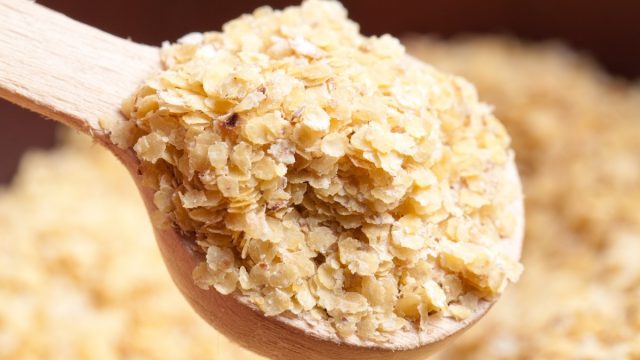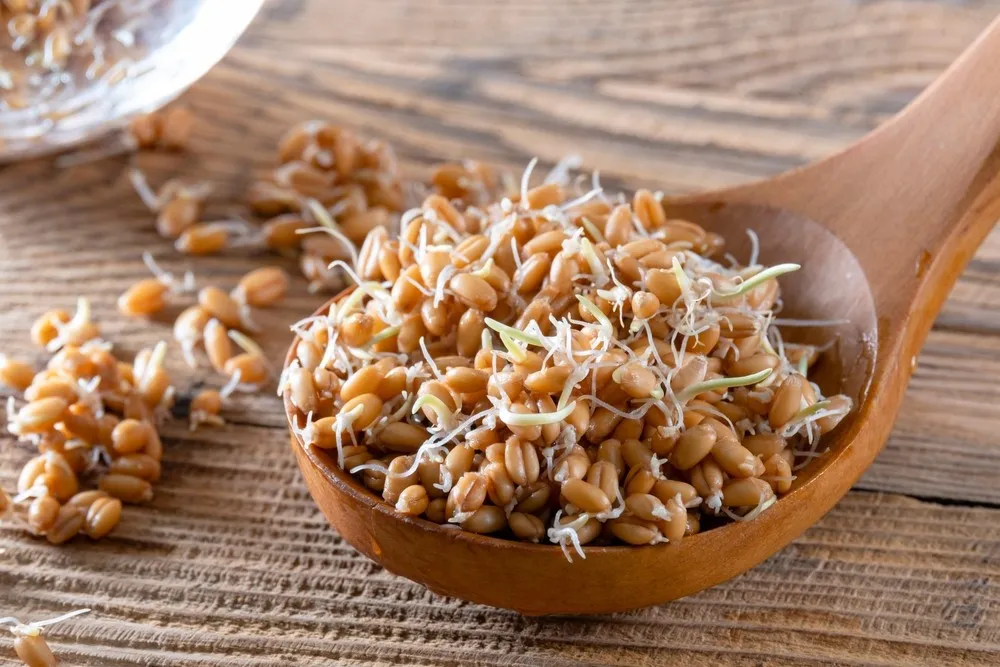7 Top Health Benefits of Adding Wheat Germ to Your Diet

There are some superfoods that you probably hear about often: Kale, berries, and green tea, for instance, are all well-traveled topics in the wellness world. That’s for good reason. When you expend minimal effort to add them to your diet, you can reap maximum health benefits later down the line. This is no less true for lesser-known superfoods, including but not limited to wheat germ.
Wheat germ is the part of wheat grain that allows the plant to reproduce. While whole grains are generally beneficial, experts say that this portion of the wheat plant is especially worthwhile for its wellness perks. In fact, Mayo Clinic names it among the top 10 greatest health foods, right alongside better-known nutritional powerhouses such as legumes, cruciferous veggies, and salmon. With that in mind, read on to learn the six greatest wheat germ benefits.
RELATED: Doctors Share 6 Health Benefits of Chia Seeds—And How to Eat Them.
1
It’s nutritionally dense.

Given its superior nutritional profile, wheat germ can help you meet your nutritional goals. In particular, it’s got ample plant protein, fiber, healthy fats such as omega-3s, and vitamins and minerals, including magnesium, zinc, folate, potassium, thiamine, phosphorus, and more.
“At just 45 calories and one gram of unsaturated fat, a two tablespoon-serving of wheat germ offers two grams of dietary fiber, 10 percent of the recommended daily value of folate, 8 percent of your recommended daily value of phosphorus, magnesium and zinc, 15 percent of your vitamin E and 10 percent of your thiamin requirements,” writes Bob’s Red Mill, a company known for its cereals, flours, and grains.
2
It can help you lose weight.

There are several ways that eating wheat germ could help you lose weight.
“Wheat germ contains higher levels of insoluble fiber,” Amy Lee, the head of nutrition for Nucific, recently told Health Digest. “With added fiber into one’s diet, we are talking about feeling more satiated and keeping one fuller longer. So that would help one not eat as much and implement some caloric deficit.”
Wheat germ’s high protein content can also suppress hunger hormones that trigger sudden food cravings. By curbing these impulses, you’ll be able to make better meal choices moving forward.
RELATED: 9 High-Fiber Foods for Weight Loss That Will Keep You Full and Satisfied.
3
It can help lower your blood pressure and cholesterol.

Eating wheat germ could also help you lower certain cardiovascular risk factors.
“Fiber helps with drawing out toxins and inflammation from the body which helps with cholesterol… and even blood pressure,” Lee said.
4
It may improve your skin.

You may have heard that using topical wheat germ oil can improve your skin by moisturizing and protecting it, but television host, food writer, and chef Daphne Oz says that eating wheat germ can also have skin-boosting benefits.
In a recent TikTok post, Oz described wheat germ as “the tender, nutritious heart of the wheat kernel,” and notes that “it has lots of good things in it including vitamin E, which is good for your skin.”
Wheat germ also contains antioxidants and anti-inflammatory properties, both of which can soothe skin irritation.
RELATED: 10 Best Foods and Drinks for Brain Health, According to New Research.
5
It could enhance your gut health and improve inflammation.

According to the USDA’s Research, Education, and Economics Information Center, eating wheat germ can also improve your gut health, which can have far-reaching effects on your broader health.
They explain that the fiber found in wheat germ acts as a prebiotic in the gut, which helps protect the microbiota, epithelial cells, and immune cells. It also helps to maintain the gut lining to limit gut permeability and prevents dysbiosis or bacterial imbalance within the gut.
This helps to prevent “systemic inflammation, a factor linked to obesity and its comorbidities,” the USDA writes.
6
It could improve insulin resistance.

According to a 2023 study published in the journal Nutrition Research, eating wheat germ may lower your risk of Type 2 diabetes by improving insulin resistance.
“Evidence has demonstrated that oxidative stress plays a crucial role in regulating cellular glucose metabolism,” the study says. “In previous studies, wheat germ peptide (WGP) was found to effectively mitigate oxidative stress induced by high glucose. Based on the information provided, we hypothesized that WGP could exhibit antihyperglycemic and anti–insulin-resistant effects in cells.”
Researchers ultimately concluded that consuming wheat germ could, in fact, enhance glycogen synthesis, inhibiting gluconeogenesis (the conversion of non-carbohydrates into glucose), improving glucose metabolism, and alleviating insulin resistance.
RELATED: 5 Signs You Aren’t Eating Enough Leafy Greens, Nutritionists Say.
7
It may protect against chronic illness.

Systemic inflammation is at the root of various chronic illnesses, which is why some scientists say that the anti-inflammatory properties found in wheat germ could help protect against inflammatory diseases. These can include neurodegenerative diseases, autoimmune diseases, metabolic diseases, various cancer types, and more.
In fact, a 2024 study published in the journal Frontiers in Microbiology notes that in particular, “wheat germ has demonstrated preventive effects against the development of colon cancer, breast cancer, and cardiovascular disease.”